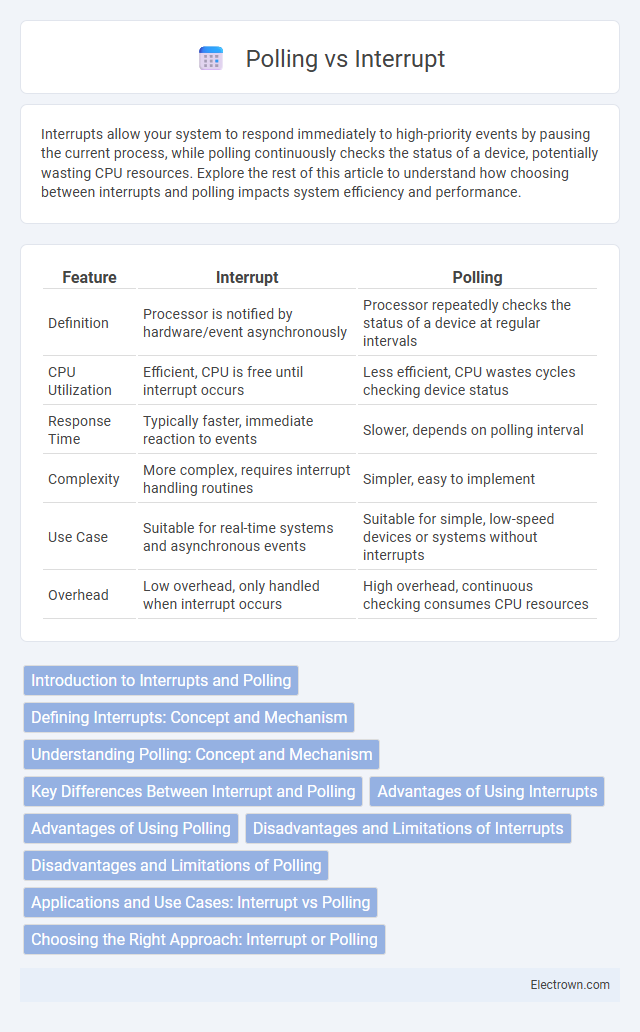Interrupts allow your system to respond immediately to high-priority events by pausing the current process, while polling continuously checks the status of a device, potentially wasting CPU resources. Explore the rest of this article to understand how choosing between interrupts and polling impacts system efficiency and performance.
Table of Comparison
| Feature | Interrupt | Polling |
|---|---|---|
| Definition | Processor is notified by hardware/event asynchronously | Processor repeatedly checks the status of a device at regular intervals |
| CPU Utilization | Efficient, CPU is free until interrupt occurs | Less efficient, CPU wastes cycles checking device status |
| Response Time | Typically faster, immediate reaction to events | Slower, depends on polling interval |
| Complexity | More complex, requires interrupt handling routines | Simpler, easy to implement |
| Use Case | Suitable for real-time systems and asynchronous events | Suitable for simple, low-speed devices or systems without interrupts |
| Overhead | Low overhead, only handled when interrupt occurs | High overhead, continuous checking consumes CPU resources |
Introduction to Interrupts and Polling
Interrupts are hardware signals that immediately alert the processor to high-priority events, enabling efficient and prompt task handling without continuous CPU monitoring. Polling involves the CPU repeatedly checking the status of a device or flag to determine if attention is required, which can lead to increased CPU utilization and slower response times. Both methods serve to manage I/O operations, with interrupts offering more efficient resource usage compared to the constant cycle of polling.
Defining Interrupts: Concept and Mechanism
Interrupts are signals sent by hardware or software to the processor, prompting immediate attention and temporarily halting the current execution flow to handle critical tasks. This mechanism enhances system efficiency by allowing the CPU to respond promptly to important events without the need for constant monitoring. Understanding interrupts enables you to optimize real-time processing and resource management in embedded systems and operating system design.
Understanding Polling: Concept and Mechanism
Polling is a technique where the CPU repeatedly checks the status of a peripheral device at regular intervals to determine if it requires attention. This method involves your processor actively querying the device's status registers, leading to continuous CPU involvement and potential inefficiencies. While straightforward to implement, polling can cause wasted processing cycles compared to interrupt-driven mechanisms, especially under low device activity conditions.
Key Differences Between Interrupt and Polling
Interrupts trigger the CPU to immediately stop its current tasks and execute a specific service routine upon an event, ensuring efficient and timely response without continuous CPU involvement. Polling requires the CPU to repeatedly check the status of a device or condition, leading to higher CPU usage and potential delays in handling events. Key differences include interrupt-driven systems enabling asynchronous handling with lower latency, whereas polling is synchronous and can result in wasted processing cycles.
Advantages of Using Interrupts
Interrupts enable your system to respond immediately to critical events, improving overall efficiency by freeing the CPU from constant status checks required in polling. This method conserves processor resources and reduces latency, allowing prompt handling of input/output operations. By prioritizing urgent tasks, interrupts enhance real-time performance and system responsiveness in multitasking environments.
Advantages of Using Polling
Polling offers precise control over timing by allowing the processor to check device status at defined intervals, which simplifies debugging and system predictability. It reduces the complexity of interrupt-driven programming by eliminating the need for interrupt service routines, thereby promoting straightforward sequential code execution. Polling ensures consistent processor availability, avoiding the overhead associated with frequent interrupt handling and context switching.
Disadvantages and Limitations of Interrupts
Interrupts can cause complexity in system design due to the need for handling multiple interrupt requests and prioritizing them efficiently, which may lead to increased latency in critical real-time applications. Frequent interrupts can overwhelm the processor, resulting in interrupt storms that degrade overall system performance and reduce CPU availability for executing main program tasks. Additionally, interrupts require dedicated hardware support and sophisticated software management, making them less suitable for simple or resource-constrained embedded systems.
Disadvantages and Limitations of Polling
Polling causes increased CPU overhead as the processor continuously checks the status of a device, leading to inefficient use of system resources. It can result in latency issues when the CPU misses timely device status changes due to fixed polling intervals. Polling struggles with scalability, as frequent status checks become impractical with multiple devices, reducing overall system responsiveness and performance.
Applications and Use Cases: Interrupt vs Polling
Interrupts are ideal for applications requiring immediate attention, such as real-time systems, embedded devices, and hardware event detection where quick response is critical. Polling suits scenarios with predictable timing or low-frequency events like simple sensor monitoring or user input scanning, where system resources can be periodically checked without missing critical data. Your choice between interrupt and polling depends on the application's need for responsiveness and resource efficiency.
Choosing the Right Approach: Interrupt or Polling
Choosing between interrupt and polling depends on your system's real-time requirements and resource availability. Interrupts are ideal for time-sensitive applications, allowing the processor to respond immediately to events without continuous checking, which conserves CPU cycles. Polling suits simpler or lower-priority tasks where periodic status checks are sufficient, ensuring predictable control flow in your design.
Interrupt vs Polling Infographic

 electrown.com
electrown.com